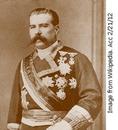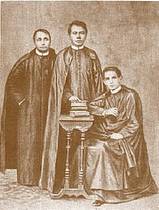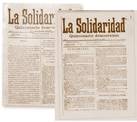|
1856 - 1890 1856: Primera Luz Filipina Masonic lodge organized in Cavite. Spanish naval captain Jose Malcampo y Monge (Monje) founded La Primera Luz Filipina in Kawit Cavite, constituted under the auspices of the Gran Oriente Lusitano of Portugal. He was joined by another officer Casto Mendez Nuñez in 1859 and another lodge was founded in Zamboanga later. These lodges were composed of officers from the Navy, Army, and government employees, all Spaniards. In 1862, Malcampo was wounded while fighting the Muslims in Mindanao. He and Mendez Nuñez returned to Spain. Malcampo would later return to the country to serve as Governor General of the Philippines from June 18, 1874 to February 28, 1877. 1868: German and British lodges established in Manila. A German Consul General and other foreigners organized a German Lodge in Manila under the Scottish Rite in Hong Kong. The British Consul also organized a lodge in Nagtahan (Manila) also under a Lodge in Hong Kong of the Scottish Rite, where Jose Rizal’s half-uncle, Jose Alberto Alonzo belonged. Both lodges admitted prominent “Filipinos” (generally insulares, creoles or mestizos.) 1872: Masons suffer persecution after the so-called Cavite Revolt. The January 20 revolt was actually a mutiny (“Motin de Cavite” ) of native military and other personnel working at the Cavite arsenal and navy yard. They seized Fort San Felipe in protest to the withdrawal by the new Governor General, Rafael Izquierdo, of their exemption from mandatory labor (polo y servicio) and paying of tributes granted earlier by liberal Governor General Carlos Maria dela Torre. Its leaders were killed but, the event was exploited by the friars and Izquierdo to suppress the growing nationalist feelings among the natives and implicate many prominent Filipinos and liberal minded intellectuals. Foremost were Filipino priests Mariano Gomez, Jacinto Zamora and Jose Burgos who were publicly garroted. Imprisoned or exiled to distant colonies were many Filipino Masons. 1872: Gran Oriente de España appoints Grand Delegate. Rufino Pascual Torrejon arrived in the Philippines; vested with powers to organize lodges in the country. 1874: Spanish lodges established in Manila, Cebu and Iloilo. Rufino Pascual Torrejon and Mariano Marti a peninsular Spanish doctor organized Spanish lodges in the Philippines. Marti organized Logia Luz de Oriente No 6 in Manila on March 1, 1874; then Logia La Española in Cebu and Logia La Libertad in Iloilo. 1874: Malcampo orders elimination of Filipinos from Spanish lodges. Jose Malcampo (founder of the Portuguese Primera Luz Filipina) assumed office as Governor General on June 18, 1874. He recommended to the Minister of Colonies the pardoning of those imprisoned in the country because of the Cavite Revolt (mutiny) but in a letter to the Minister on July 7, 1874, he reported the growth of Masonry in the Philippines and expressed his fears that its existence would become inimical to Spain should its native members (Filipinos) become the majority and lead the secret society (Masonry) into activism. Malcampo in doing what he promised the Minister that he would impede and keep the sphere of influence of the Filipinos, ordered their elimination from the lodges and the reorganization of the Fraternity under the Gran Oriente de España. Torrejon complied and constituted a District Grand Lodge. 1875: District Grand Lodge unveils organizational plan. The District Grand Lodge under the Gran Oriente de Espana was installed March 1, 1875 with Torrejon acting as Grand President, and Juan Utor y Fernandez as Gran Maestro Adjunto. Their General Regulations containing an organizational plan was approved by the Gran Oriente de España on March 20, 1876. The plan included the establishment of a Provincial or Regional Lodge under which were Symbolic Lodges, a Chapter of the Royal Arch, a Sovereign Chapter of Rose Croix and a Chamber of Knights Kadosh. 1879: Torrejon establishes more lodges. Torrejon’s District Grand Lodge formed four lodges in Manila, one in Iloilo, one in Cebu and two in Cavite. A Chamber of Knights Kadosh, a Chapter of Rose Croix and a Grand Triangle of the Royal Arch were constituted in each of these cities. 1884: Another Spanish Grand jurisdiction, the Gran Oriente Nacional de España arrives in the Philippines. The Gran Oriente Nacional de España was introduced into the country by its Grand Delegate, Jose Centeno. Mariano Marti’s Logia Luz de Oriente No. 6 (1874) transferred to this Orient and was re-chartered. Centeno was chief of the Mining Bureau in the Philippines from 1876 to 1886. On April 30, 1887 he was appointed Civil Governor of Manila. 1886: Filipinos join formation of Logia Solidaridad in Spain. Logia Solidaridad was founded in Barcelona by two Filipinos, Rafael del Pan and Ricardo Ayllon; three Cubans, a Puerto Rican and two peninsular Spaniards. They were joined later by two other Filipinos, Julio Llorente and Evaristo Aguirre. Dissolved in 1887, this move however established Filipino contacts with Masonry and Miguel Morayta (Schumacher, 1997). Julio Llorente would be the Master of the Lodge and Marcelo del Pilar the Senior Warden upon its revival in Madrid in 1890 while Morayta would be a key figure in Philippine Masonry and the campaign for colonial reforms. 1888: Fusion of the Gran Oriente de España and Gran Oriente Nacional. The Gran Oriente de España in Spain suffered a series of upheavals after the resignation of its Grand Master, Manuel Becerra in 1886 over the discovery of mishandling of funds by the Office of the Grand Secretary. On April 4, 1888, around 160 lodges sent their representatives to an assembly for the fusion of the Oriente Nacional with the Gran Oriente de España. However, charges of fraudulence marred the ensuing elections. Miguel Morayta together with about ninety lodges left the newly formed union of the two Orients. 1889: Morayta founds Grande Oriente Español. On January 9, 1889 Miguel Morayta y Sagrario (1834-1917) founded Grande Oriente Español. Morayta was a professor at the Universidad Central Madrid and became the Secretary General of the Ministry of State during Spains’ First Republic. He was initiated into Masonry in Logia Mantuana de Madrid and used the symbolic name Pizarro. He served as Grand Master of the Grande Oriente Español from 1889 to 1901 and again from 1906 until his death in 1917. 1889: Morayta joins Filipino movement. On January 12, 1889 the Asociación Hispano-Filipina (Hispanic-Filipino Association) was inaugurated in Madrid with Miguel Morayta as president. Composed of Filipino and Spanish Masons, the association worked hand-in-hand with Marcelo del Pilar, Jose Rizal, Mariano Ponce, Antonio Luna and other Filipino propagandists in seeking colonial reforms for the Philippines. 1889: First predominantly Filipino lodge founded in Spain. Logia Revolución, the first predominantly Filipino lodge was founded in Barcelona with Graciano Lopez Jaena as Worshipful Master, Mariano Ponce as Secretary and members Marcelo del Pilar, Jose Maria Panganiban, and two Cubans; chartered by the Grande Oriente Español on April 1, 1889. The lodge was dissolved when Marcelo del Pilar moved the propaganda campaign to Madrid. 1890: Logia Solidaridad revived. Logia Solidaridad was revived in Madrid and issued a charter (number 53) by the Grande Oriente Español on May 15, 1890 with Julio Llorente as Worshipful Master and Marcelo del Pilar as Senior Warden. (Kalaw 1920) Del Pilar succeeded Llorente as Worshipful Master in January 1891. This lodge drew together all Filipino Masons and became a forum of nationalistic ideas. 1890: Morayta issues authorization to organize Philippine Masonry. Plan to organize Philippine Masonry and establish Masonic lodges in Manila and the provinces was initiated by Marcelo del Pilar and Dr Jose Rizal with the aim of “forming a strong united league and teach Filipinos to make use of their freedom of thought and speech”. Del Pilar secured an authorization from Miguel Morayta, Grand Master of Grande Oriente Español. Antonio Luna and Pedro Serrano Laktaw were appointed for the task. Luna prepared regulations and a complete plan of organization but was unable to return to the Philippines because of his trip to Paris, France. Read more: 1890-1900 |
The founding of the first lodge Jose Malcampo
Jose Malcampo was a young Spanish Naval officer when he was sent to Cavite in the Philippines and assigned to the ship Reina Castilla. He arrived at a time when there were irritants between the Spanish Navy and the authorities in Hong Kong, Macao and other foreign ports. One source of ill feeling according to Kalaw (1920) was the Spanish campaign against the Moro pirates of Mindanao because the Spaniards believed that these pirates were receiving certain protection from Europeans. The strained relations escalated into serious conflict when the Spanish Navy started loading cargo for foreign ports; one incident so serious, it almost caused a shooting confrontation between the English and Spanish Navies if not for the intervention of the Governor of Hong Kong and the Cabinets of Madrid and London.
One advantage the foreigners in other colonies had, wrote Kalaw, was their membership in the various Masonic Lodges scattered in Hong Kong, Singapore, Java, Macau and other ports. This advantage, deemed useful to the Spanish Navy was the motivation for the establishment of the Lodge in Cavite and later in Zamboanga. Since most of the Lodges in Spain at that time were under the Gran Oriente Lusitano, this Grand Jurisdiction was chosen for Primera Luz Filipina. In 1868, six years after Malcampo returned to Spain, he took part in the revolution that deposed the Monarchy and Queen Isabella II. He later served the government in different positions until he was again assigned to the Philippines as Governor General in 1874. Prelude to Filipino activism Gomez, Burgos and Zamora
One of the leaders of the Spanish revolution of 1868 was a Mason, General Juan Prim, who became Regent in 1869 and in whose administration served Segismundo Moret as Minister of Overseas Colonies. Moret who was also a Mason and a liberal immediately instituted reforms for Spain's colonies. These were implemented in the administration of the Philippines when another Mason and a liberal Governor General, Carlos Maria dela Torre was assigned to the country on June 23, 1869.
The reforms and innovations implemented by Governor Dela Torre were never seen before in the colony. These included free public discussion of social and political issues; partial secularization of education and government control over some educational institutions previously dominated by the friars. He also lifted censorship of the press, and provided exemptions from forced labor and payment of tributes. He also fraternized with mestizos and native Filipinos. These were well appreciated by the Filipinos, particularly the growing ranks of intellectuals and Filipino secular priests but angered the religious corporations headed by Spanish friars who saw a threat to their influence. The Spanish friars were especially fearful of the nationalist feelings being promoted by the liberal atmosphere and the heightened campaign of Filipino secular priests, headed by Father Jose Burgos, for the secularization of the parishes and the assignment of Filipino priests. But conditions changed when the Spanish Parliament restored Monarchy in Spain and the Regent, General Juan Prim was assassinated on November 27, 1870. Their campaign suffered a setback as their ally, Governor General Carlos dela Torre was recalled to Spain on April 4, 1871 reportedly, through the agitation of the friars. Less than a year later, the friars permanently silenced Father Burgos by convincing the new Governor General, Rafael Izquierdo of Burgos' complicity, together with Fathers Gomez and Zamora in the so called Cavite Revolt (Cavite Mutiny). The three priests were publicly executed by garrote on February 17, 1872. Many liberals, intellectuals and Masons were imprisoned or deported. As persecution continued, some were able to flee to Spain to avoid arrest. Those who fled to Spain were later joined by Filipinos who were studying in Spanish and other European universities and together, they started a movement for reforms which also led to the organization of Masonic lodges in the Philippines. The Filipino movement in Spain Lopez Jaena / MH del Pilar / Rizal / Ponce / Luna / Morayta
Graciano Lopez Jaena and Marcelo H. del Pilar were among those who fled the country to avoid arrest. Some of those who went to Spain to pursue higher studies were Jose Rizal, Mariano Ponce, Galicano Apacible, Jose Ma. Panganiban and Antonio Luna. Together, they would be known as the prime movers of what history books call the Propaganda Movement.
La Solidaridad
In December 1888, an organization called La Solidaridad was formed, headed by Galicano Apacible. In February 1889, a fortnightly newspaper called La Solidaridad was launched, initially edited by Graciano López Jaena and ten months later, by Marcelo del Pilar. This newspaper addressed the Spanish and European audiences so they might know the conditions and the needed reforms in the Philippines. It attracted many contributing writers like Ferdinand Blumentrit and Miguel Morayta. Morayta for his part also actively worked to promote Filipino interests as president of the Asociación Hispano-Filipina and helped the campaign for the reinstatement of Filipino representation in the Spanish Cortes. Running out of funds, plagued with internal problems and weary of the apathy shown by the Central government in Madrid, La Solidaridad printed its last issue on November 15, 1895. Less than a year later, the Philippine revolution started.
|
